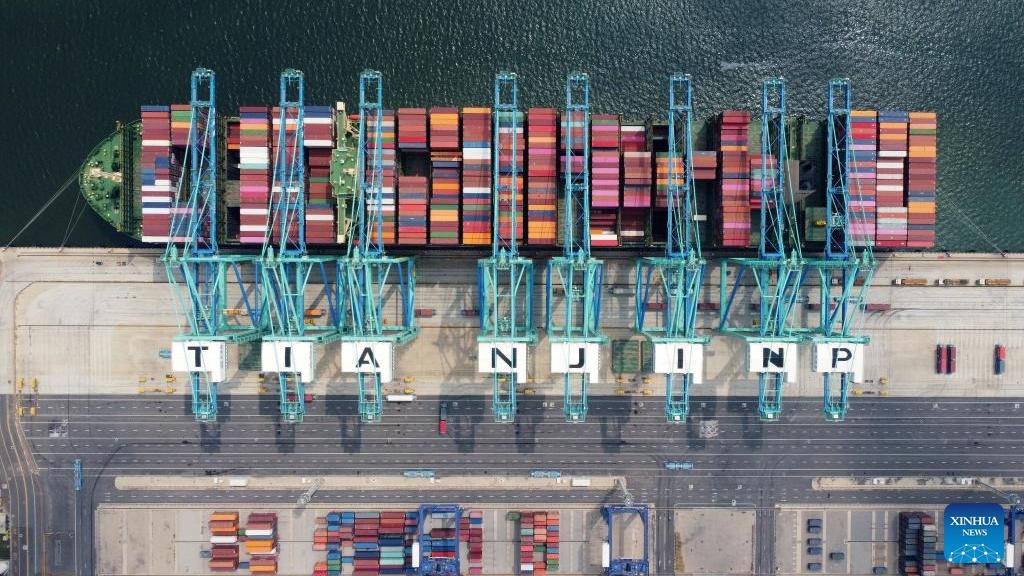 This aerial photo dated July 7, 2023 shows a cargo ship at a smart container terminal of Tianjin Port in North China's Tianjin. (PHOTO / XINHUA)
This aerial photo dated July 7, 2023 shows a cargo ship at a smart container terminal of Tianjin Port in North China's Tianjin. (PHOTO / XINHUA)
BEIJING - The Beijing-Tianjin-Hebei region has achieved remarkable progress in high-quality development over the past decade, an official said on Tuesday.
In early 2014, China initiated a key strategy to coordinate the development of Beijing, Tianjin, and Hebei - a regional city cluster called "Jing-Jin-Ji".
The region has made headway in building a comprehensive transport system, which has helped improve urban management and cross-regional coordinated development, Guo Lanfeng, a senior official with the National Development and Reform Commission, told a press conference.
A one to one-and-a-half-hour traffic circle linking major cities in the region has basically been formed, Guo said.
ALSO READ: Beijing-Tianjin-Hebei region sees foreign trade growth
The region has also seen huge improvements in its ecological environment over the past decade. In 2023, the average concentration of fine particulate matter (PM2.5) in the region had dropped by nearly 60 percent compared with the 2014 level.
"'Beijing blue' has become a normal for the Chinese capital," Guo said, in reference to the sky over Beijing.
 A truck passes through the Fangshanbei toll station of the Beijing-Xiong'an Expressway on Dec 28, 2023. (DENG WEI / FOR CHINA DAILY)
A truck passes through the Fangshanbei toll station of the Beijing-Xiong'an Expressway on Dec 28, 2023. (DENG WEI / FOR CHINA DAILY)
Ridding Beijing of 'urban ills‘
A prominent aim of the Jing-Jin-Ji coordinated development strategy has been to move non-capital functions out of Beijing to counter various "urban ills" in the Chinese capital, such as traffic jams and pollution.
Since the implementation of the strategy, Beijing has resettled 3,000 manufacturing enterprises, and relocated or upgraded nearly 1,000 markets and logistics centers.
ALSO READ: Beijing, Tianjin, Hebei come closer for development
Several universities have begun building new campuses in Xiong'an New Area of Hebei province, while the headquarters of some state-owned enterprises have moved from Beijing to other cities, which is conducive to the national economic layout, said Guo Lanfeng, a senior official with the National Development and Reform Commission
Several universities have begun building new campuses in Xiong'an New Area of Hebei province, while the headquarters of some state-owned enterprises have moved from Beijing to other cities, which is conducive to the national economic layout, Guo said.
"Beijing's urban ills will be further alleviated in the future, and its capital functions will be more fully demonstrated," he said.
Bridging development gap
The Jing-Jin-Ji coordinated development strategy also aims to bridge the development gap between Beijing, Tianjin and Hebei.
Over the past 10 years, enterprises in Beijing's Zhongguancun area, known as "China's Silicon Valley", have established more than 10,000 branches in Tianjin and Hebei.
In 2023, the container throughput of Tianjin Port exceeded 22 million twenty-foot-equivalent units, an increase of 58 percent over 2014 and ranking eighth globally.
READ MORE: Beijing, Tianjin and Hebei coordinate tourism development
The strategy also boosted the development of tourism in Hebei province, which has rich resources including four world cultural heritage sites, said Zhang Chengzhong, executive vice-governor of Hebei.
The province received 840 million tourists last year, including 120 million from Beijing and Tianjin. And the proportion of tourists from the two cities continues to increase, according to Zhang.
"Beijing, Tianjin and Hebei will continue to expand the breadth and depth of cooperation in the future, and push the coordinated development of the region to a new level," Guo said.


